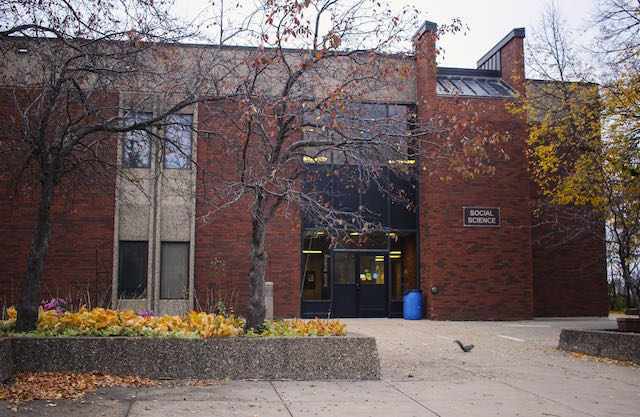Comprehensive Facilities Plan nears completion with major space reconfiguration changes proposed
With the plan incomplete, it is not a guarantee all changes will happen
With the Comprehensive Facilities Plan (CFP), formerly called the Facilities Master Plan, now 95 percent complete, Vice President for Finance and Administration Deb Kerkaert and Provost Dwight C. Watson presented an update at the Oct. 13 Student Association meeting.
The plan, which is required by all Minnesota State colleges and universities, includes conceptual ideas for reconfiguring space and other construction projects at SMSU. Kerkaert said the last CFP that SMSU completed was 12 years ago, and that this will be a total upgrade of the plan.
“The CFP is to provide a tool for future decision making that supports the academic mission and sets a logical course for capital improvements over the next two to 30 years,” Kerkaert said.
Kerkaert said updating the CFP began a little over a year and a half ago. An SMSU committee comprised of representatives from administration, bargaining units and students chose LHB, a Duluth-based consulting firm, to assist with the plan. LHB must submit reports at 35, 65 and 95 percent completion. A representative from LHB was on campus Oct. 12 to present the 95 percent completion report.
Outcomes of the report
Based on information from various meetings throughout the last academic year, LHB presented a list of six goals that the CFP should accomplish. They are to improve the student experience, improve space utilization and improve classroom conditions, improve wayfinding, improve student support, update learning environments and improve student life.
Kerkaert and Watson provided more specifics of what the priorities of the CFP are at the Oct. 13 Student Association meeting. Now, all the priorities LHB outlined are conceptual and can change during pre-design.
One priority is taking the Social Science building “offline.” This would mean the building would sit empty, be rented out to another tenant or be demolished. This is because the State of Minnesota considers the campus to be underutilized, citing that the classroom space is only used 52 percent of the time, based on a 32-hour week.
The optimal space utilization rate should be between 80 and 85 percent. This means about 14 classrooms must be cut. The State of Minnesota will not provide funding for future projects unless the campus’s space is utilized effectively.
“Part of the reason for demolishing, not that anybody wants to take space away, is we won’t get to remodel unless we utilize our space better,” Kerkaert said. “And the only ways to get our utilization up is to increase enrollment by [500 to 1,000 students], or to reduce our classrooms.”
It is also suggested that student services such as Financial Aid, Registration, Admissions and Business Services be moved to one location on the first floor of Charter Hall. Doing so would ensure students are not sent to different areas for different needs. Similarly, the Office of Student Success, Career Services and Counseling and Testing Services is to be moved together under the plan.
The CFP also calls for integrated science centers and selective lab upgrades. It also says that the Academic Commons should be moved to a new location, such as the library.
“This is in concept; it’s not specific. It doesn’t have to be ‘that floor’ or ‘that building’ but it’s the concepts that are important,” Kerkaert said.
Aspects met with opposition
Though many of the CFP’s priorities are based on the goal of improving the student experience, many in the audience at the Student Association meeting expressed concerns with the plan, especially the demolishment of the Social Science building and moving the Academic Commons.
Demolishing the Social Science building would displace the Social Science Department, Museum of Indigenous Americans, Southwest History Center, Veteran’s Center, and the dance studio, among others. Watson assured that anything that would be displaced because of the CFP would be replicated somewhere else, although no specific places were suggested at the meeting.
Students also pointed out that if social science classrooms were moved, they might not be together anymore, or be conveniently near the research lab and social science professors. Watson said that this can be worked out during pre-design, but “we cannot guarantee proximity.”
Watson also addressed concerns that demolishing a building would cap the number of students who would be able to enroll, saying that SMSU can maintain its current capacity of 4,000 with the remaining buildings.
“These are recommendations, not actualities,” Watson said. “There’s no finality here.”
Members of the audience were also opposed to the relocation of the Academic Commons. Senior Wilson Ebner, who is the president of the SMSU chapter of the Education Minnesota Student Program, says that the location of the Academic Commons is critical to the success of education majors because of its unique environment and location.
“There is no other place in the school where education majors feel comfortable to speak with their groups in a normal voice without worrying about affecting the people around them,” Ebner said.
Ebner says once accepted to the Education Program, a student may spend up to 15 hours a week or more in the Academic Commons completing lesson plans, working with groups and utilizing the Education Curriculum Library.
“Most education majors and education alumni are outraged by the move,” Ebner said. “I have had many alumni come back to me asking what they can do to prevent this move. Many people will testify saying their success of the program was because of the Academic Commons.”
Currently, the Academic Commons is located next to the Education Department, so students can easily connect with their professors. Watson said that under the current plan, the Academic Commons would be maintained, though it would not be as proximal once relocated.
“Many professors have commented that they no longer would use the Academic Commons if it was moved to another location because the proximity of it wouldn’t be beneficial for their classes,” Ebner said.
Kerkaert says that the CFP, once approved, will not be implemented immediately. The pre-design work could take up to two years to complete. The earliest SMSU would be able to request the funding through the Minnesota State Legislature is 2020, and it likely would not be funded on the first request. Kerkaert estimates a minimum of six to eight years for funding to be received and any construction to begin.

Kevin Danielson is a Professional Writing and Communications major, with minors in Marketing and Public Relations. He has been a writer for The Spur since...


